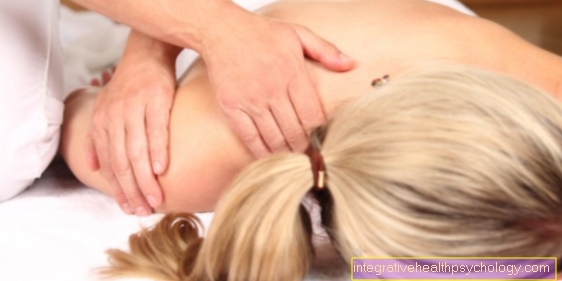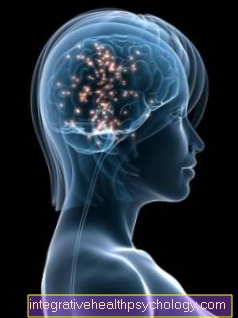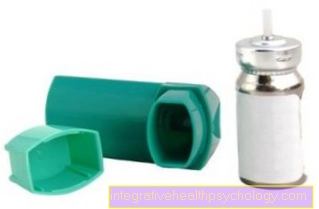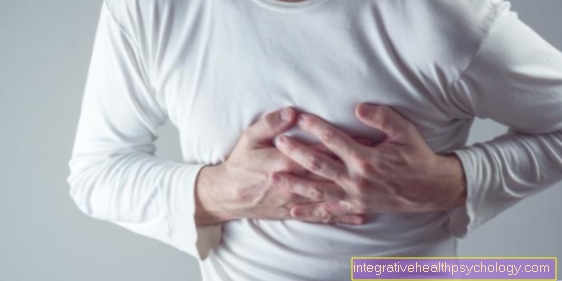Pain in the kidney area
definition
Pain in the kidney (s) can have various causes. First of all, however, it must be clarified whether the pain is actually caused by the kidneys, since back pain can often be interpreted as kidney pain. Depending on the intensity, duration and type of accompanying symptoms, the family doctor should be consulted in order to initiate further diagnostic measures if necessary.
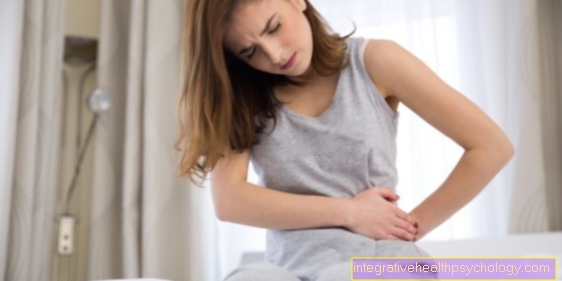
Causes of pain in the kidney area
Pain in the kidney area does not always actually come from the kidney.
A much more common cause is back pain radiating into the flanks.
Back pain can be caused by muscular tension, degenerative changes (age-related wear and tear), broken bones (vertebral body fractures), disc disease or even malignant processes.
If the pain is actually due to a disease of the kidneys or the urinary tract, various diseases come into question as the cause.
The most common cause of pain in the kidney region and the lower urinary tract are kidney stones (Nephrolithiasis). Kidney stones usually only cause symptoms when they get from the kidney into the ureter.
Large stones cannot simply run off with the urine through the ureter, but instead get stuck. The muscles of the ureter work against it and try to transport the stone further. This leads to very severe colicky pain. So the pain comes in waves.
Depending on the height of the ureter and how fast the stone is located, the pain is localized first in the area of the flanks, later in the lower abdomen up to the groin and shortly before the stone enters the bladder in the genital region .
Another cause of pain in the kidney is inflammation of the renal pelvis (Pyelonephritis). It is accompanied by dull, pressing pain, usually in the area of only one kidney bed. In addition, the general condition is usually significantly reduced, there is a high fever, often accompanied by chills. The cause of kidney inflammation is caused by bacteria that have risen to the kidneys via the urethra, ureter and bladder. Renal pelvic inflammation often arises from an untreated cystitis.
Another kidney disease is glomerulonephritis (inflammation of the kidneys). There are many different sub-forms here.
Pain is a rare symptom, but it can happen. Accompanying glomerulonephritis can lead to water retention (edema), especially in the legs but also on the eyelids, increased blood pressure values and blood in the urine (Hematuria) come.
Cysts that may grow in the kidney tissue (kidney cysts) also cause pain. Often, however, such cysts are completely asymptomatic and are accidentally noticed during ultrasound or other imaging. If there are very many or particularly large cysts, this can lead to pain and impaired function of the kidneys.
Cancer of the kidney (Renal cell carcinoma) can be associated with pain. Usually, however, these diseases only become noticeable in the form of pain at a significantly advanced stage. In classic cystitis, the pain is not localized in the kidney area but in the area of the lower abdomen and urethra. They then mainly appear as burning pain while urinating.
You might also be interested in:
- Causes of Kidney Pain
- Flank pain on both sides
Classification of kidney pain according to its location
Kidney pain on the right side
The cause of kidney pain is not different for the right and left kidneys. There are diseases that tend to affect both kidneys and diseases that usually only occur in the area of one kidney.
However, there are no typical diseases that mainly affect the right or especially the left kidney.
Glomerulonephritis is a typical disease of both kidneys that can be associated with pain. This is an inflammation in the area of the kidney tissue. Pain is not a typical symptom, but it can occur.
A typical unilateral kidney disease that is associated with pain is pelvic inflammation.
Kidney cysts can be found in either or both kidneys.
Kidney stones are often found in both kidneys.
However, renal colic from a stone trapped in the ureter usually occurs on only one side.
Read more on the topic: Kidney pain on the right side
Kidney pain on the left side
As already described in the previous section, there are no diseases that are specific to one or the other kidney. Some diseases tend to affect one kidney, while others tend to affect both kidneys. Pain that is localized in the right or left kidney region does not have different causes that are specific to the right or left.
Read more on the topic: Left kidney pain
Kidney pain associated with digestive tract disorders
Diseases in the digestive tract rarely cause pain in the kidney area.
Diseases of the pancreas can lead to a belt-shaped radiation in the back, but this tends to affect the upper part of the back.
Diseases of the blood vessels and the heart can also radiate to the back, but pain in the kidney area is rather untypical.
Bilateral kidney pain
Bilateral kidney pain can occur, for example, in diseases such as glomerulonephritis. However, pain is not one of the most typical symptoms of this condition.
Very large kidney cysts on both sides can also lead to pain. Renal colic can occur on both sides in patients with kidney stones, but rarely at the same time. The pain can then be localized in the flank, but also in the lateral lower abdomen, the groin or the genital region.
With inflammation of the renal pelvis, one kidney is usually very painful, but a rather dull flank pain can also occur on the other side. Chronic kidney failure, i.e. permanent kidney weakness, usually affects both kidneys, but is not associated with pain.
Diagnosis of kidney pain
The diagnosis of kidney pain is made up of several components. First of all, the anamnesis is important. The examining doctor will ask when the pain has existed, whether it is unilateral or bilateral, whether there was a trigger for the pain, where exactly it is located, whether it is always present or only occasionally occurs, whether it is wavy whether such pain has ever occurred, whether kidney stones are known, whether there are accompanying symptoms such as fever, chills, blood in the urine or water retention, whether there are previous illnesses and which medications are taken regularly.
The physical exam follows. The doctor will examine the back and kidneys, among other things.He can tap the spine to test whether it is painful, he can perform various movement tests and test the kidney bearings for knocking pain. To do this, he carefully but firmly hits the area in which the kidney is located with his fist or the edge of his hand. If this is indicated by the patient as painful, it may indicate an inflammatory process in the kidney area.
A urine status is often also recorded. To do this, the patient has to give urine. This is examined more closely either by means of a urine strip test or in the laboratory, including for the presence of inflammatory cells and blood components.
Under certain circumstances, a blood test can be useful to assess inflammation values and kidney function.
An ultrasound scan of the kidneys can also be done. Here, the size and structure of the kidneys can be assessed, cysts and kidney stones can be checked and a possible urinary blockage can be excluded.
Concomitant symptoms with kidney pain
The possible accompanying symptoms of kidney pain differ depending on the underlying disease. If there is an inflammation of the renal pelvis, there is often a high fever with chills, and the patients feel very exhausted and ill.
Kidney cysts often cause no symptoms at all.
Glomoerulonephritis can be associated with water retention. These can be located in the legs, but also in the area of the eyelids, for example.
Blood can also be added to the urine in glomerulonephritis. It is also a typical symptom of kidney stones.
Renal colic, which is caused by the passing of kidney stones, is often accompanied by severe restlessness as well as nausea and vomiting. If there is a bladder infection, it comes to burning pain when urinating and frequent urination.
Cramp-like pain in the kidney area
Cramp-like pain is often referred to as colic or colic-like pain in medical jargon. In relation to the kidney, they are typically found in kidney stones. One then speaks of renal colic. Kidney stones can enter the ureters from the kidney. Depending on how big they are, they get stuck here and cause severe, colicky pain that comes and goes in waves. Those affected often complain of extreme pain and cannot sit still, but have to move. Nausea and vomiting are also common.
You might also be interested in: Symptoms of kidney pain
Spasmodic pain and back pain
Back pain is often confused with kidney pain.
Pain originating from the back is much more common than pain originating from the kidney.
Kidney pain that is accompanied by back pain usually does not have the same cause. Of course, kidney and back pain can also occur at the same time.
Read more on the topic: How do you differentiate between back pain and kidney pain?
Therapy for kidney pain
The treatment of kidney pain depends not insignificantly on the cause.
Medicines such as ibuprofen, paracetamol or metamizole (Novalgin®) are suitable for pure pain therapy. However, the widespread ibuprofen should be avoided, especially in patients with previous kidney damage or structural kidney diseases with impaired kidney function; the use of Novalgin® is more recommended here.
If the pain is caused by inflammation of the kidney pelvis, antibiotic treatment must be initiated as soon as possible. Fever-lowering therapy is often required in the first few days. Novalgin® is again very suitable for this.
If the pain is due to kidney stones and it is renal colic, pain relievers are also used. In addition, antispasmodic agents are recommended here, especially Buscopan® (Butylscopolamine bromide).
In the case of bladder infections, it must be weighed whether antibiotic treatment is indicated. Glomerulonephritis often requires immunosuppressive therapy. Non-drug measures for kidney pain include physical rest, keeping the kidney region warm, regular warm baths or hot water bottles.
You should also drink enough. Whether the treatment can be carried out on an outpatient basis or whether it has to be inpatient depends to a large extent on the disease and its severity. Severe kidney inflammation may require inpatient treatment, as may severe renal colic with large stones.
You might also be interested in: How can I relieve kidney pain?
How long does kidney pain last?
The duration of kidney pain depends largely on the cause.
An inflammation of the renal pelvis often lasts for more than a week with antibiotic therapy until it is completely healed.
However, pain, fever and general condition usually improve within 2-3 days after starting antibiotic therapy.
Renal colic occurs at intervals and lasts until the stone is eliminated from the ureter into the bladder or completely with the urine. A single colic usually lasts minutes to hours and in most cases requires pain therapy.
Glomerulonephritis is a disease that is often chronic and requires permanent treatment.
Cancer of the kidneys is often protracted and requires surgical and / or drug therapy.
Kidney Pain During Pregnancy
Pain in the kidney area during pregnancy is a symptom that is complained relatively often. Often the symptoms are short-lived, disappear again completely and are of no relevance.
However, kidney pain during pregnancy can in individual cases also indicate increasing urinary congestion. The widening uterus can compress one or both ureters during pregnancy and thus interfere with the flow of urine from the kidney into the bladder.
If there are frequent flank pain that goes beyond a slight pull, the attending gynecologist should be consulted. This can rule out urinary congestion with the help of an ultrasound scan.
Read more on the topic: Kidney Pain During Pregnancy
Kidney pain and abdominal pain
Pain in the kidney area that is accompanied by pain in the lower abdomen may most likely indicate a bladder infection. However, kidney pain associated with a bladder infection is rare. Cystitis is usually accompanied by uncomfortable, pulling abdominal pain, especially when urinating and a constant need to urinate.
A slight pain in the kidney region can also occur rather rarely. However, he should make people sit up and take notice in connection with a cystitis, as an untreated cystitis can lead to dangerous kidney inflammation. This is accompanied by dull kidney pain, a clear knocking pain in the kidneys, fever and chills and a greatly reduced general condition.
You might also be interested in: Kidney pain when urinating
Kidney pain when lying down
Pain in the kidney area that only occurs when you are lying down is in all probability not pain that actually originates from the kidneys. It is more likely that this is back pain. Renewing the sleeping mattress can help to prevent back pain, which occurs especially when lying down. Regular training of the back muscles can also be helpful.
Kidney pain when moving
Kidney pain caused by one of the above diseases does not normally depend on whether the person is standing, walking, lying or sitting. In patients with kidney colic, i.e. kidney stones, it can often be observed that the pain makes them difficult to sit still and that they walk restlessly back and forth.
This does not significantly alleviate the pain, but the movement seems to make it a little more bearable.
Kidney pain when stooping
Pain in the kidney area, which only occurs when stooping, is probably also more caused by the back than by diseases in the kidney area. Muscular tension, degenerative changes in the bones or herniated discs can be the cause of pain, which mainly occurs when bending over.
Can kidney pain be a sign of pregnancy?
Whether pain in the kidney area can be a sign of pregnancy is difficult to give a general answer. Pregnant women report numerous different small abnormalities in early pregnancy. Mild kidney pain in early pregnancy is reported again and again. However, kidney pain is definitely not a sure or halfway reliable sign of pregnancy.











